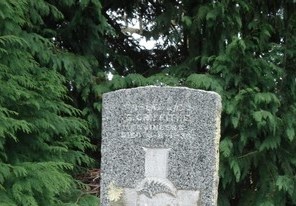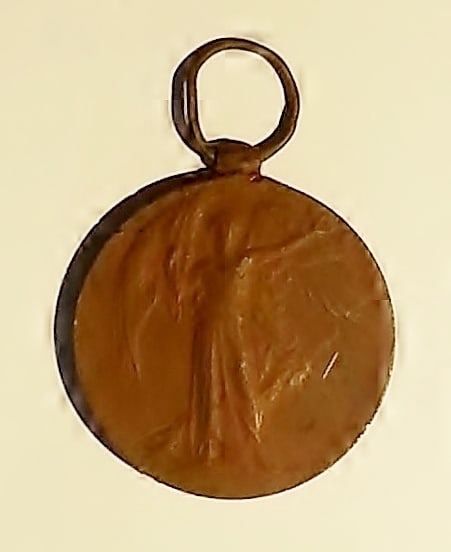9/1560 – GEORGE GRIFFITHS
In November 2016 Trish L. was in the process of packing up her house in Nelson for a new life in Auckland. It had been five years since Trish’s husband Kevin passed away, and Trish’s daughter Bridget and son- in-law Kal had come across from Blenheim to help her with the pack-up. During the packing and moving of boxes in Trish’s garage Kal spotted what looked like a medal (no ribbon) and retrieved it. The medal was in a pretty sad condition, corroded, rusty, no ribbon – just a ribbon ring somewhat distorted. On closer inspection, being an ex-RNZAF man, Kal immediately recognised it was a war medal by the name impressed on the edge: 9/1560 L.CPL. G. GRIFFITHS N.Z.E.F.
Trish had no idea where the medal had come from, certainly Kevin had never ever mentioned it. After 20 years service in the RNZAF Kal Quaife had left the RNZAF but not gone far; only about 300 yards in fact to take up a similar job as a civilian aircraft mechanic for SAFEAIR Ltd. I had known Kal from when he joined the RNZAF as I had been one of his instructors when he underwent his recruit training at Woodbourne, and during the intervening 30 odd years since then we had both been vaguely aware of where each other was, having met very briefly in passing, maybe twice? Kal had heard of Medals Reunited NZ and that I was involved so told his mother-in-law Trish he would try and find a home for the medal. Kal contacted me and the search began.
~~~~~~~~~~~~~~~~~~~~~
George Griffiths (1893), 22, and his elder brother (by one year) Harry (1892), 23, were both very fit and experienced bushmen who were working for a Mr Murphy at Tokomaru Bay on the East Cape when they had registered for war service in 1915. Their parents William and Alice Griffiths lived in Gisborne. George, a Horse Breaker and his brother Harry, a Station Hand, enlisted together on the same day in August of 1915. They even had sequential service numbers, George was 9/1560, and Harry 9/1561 and both were made Troopers of an Otago Mounted Rifles. Six weeks of preparation at Featherston and Trentham camps, a little pre-embarkation leave and then both brothers were on their way – George left in August 1915, and Harry in October, their unit making up a good proportion of the 7th Reinforcements which was destined for the port of Suez located on the western edge of the Suez Canal. As their parents were aging, both men listed their only sister Delia Griffiths as their next of kin. Aware that the Gallipoli campaign against the Turks was well under way, the Griffiths had expected that to be their first taste of action. On arrival however, both of the brothers were promptly transferred to No 1 Field Company, NZ Engineers (Pioneer Battalion) and made ready for deployment to France.
~~~~~~~~~~~~~~~~~~~~~
In Feb 1916 the George and Harry embarked for France and the Western Front. Being an Engineer meant their lives would revolve around a pick and shovel, wire cutters and sledge hammers. They could be working with the Tunneling Companies digging trenches (firing, supply, or communications) as well as saps – trenches or tunnels dug toward the enemies frontage to either secretly place mines under enemy positions, or for siting defensive machine gun posts in. Being well forward of the friendly fire trenches, these sap machine gun posts were used as early warning, to launch covert (night) patrols or attacks from, and for provide covering fire to their own advancing troops. In addition as Engineers they could be called upon to fill sandbags, build revetments to provide overhead cover in the trenches or to reinforce trench walls to prevent them collapsing during enemy bombardments, erect barbed wire obstacles or cutting paths through enemy wire, and so forth – hard and never ending work, day and night.
Trooper George Griffiths was the first to be promoted, to L/Cpl. in Nov 1916 and both brothers remained in France until Sep 1917. George had been beset with Myalgia (muscle pain) shortly after his arrival in France from which he recovered but was apparently a precursor to a bout of Rheumatic Fever in Dec 1917 which necessitated an extensive period of hospitalization. Having made his way back to health by may 1918, in June George was taken ill again, this time with Spinal Meningitis. Another long period in hospitalization resulted in George’s re-classification as “no longer fit for war service on account of Chronic Rheumatism”. That was his ticket home. The Armistice had been declared on November 11th, 1918 and so George returned to NZ on the “Maunganui” in January 1919, and his brother Harry, in February. Aside from their sicknesses the brothers arrived home in one piece however it would take its toll on George Griffiths long term health.
~~~~~~~~~~~~~~~~~~~~~
Once back in New Zealand George and Harry went straight home to their parents at 39 Adair Road in Gisborne. After a period of rest they then branched out working as a pair on various farms around the Bay of Plenty (Tuparoa) before eventually returning to Gisborne in the mid 1920s and Adair Road as their base. They both continued there farming work but operated from home in order to be able to assist their ageing parents.
~~~~~~~~~~~~~~~~~~~~~~
Awards: 1914-15 Star, British War Medal, 1914-18, and Victory Medal (awarded to both brothers)
Service overseas: 3 years 90 days (Harry – 3 yrs 160 days)
Total NZEF Service: 3 years 166 days (Harry – 3 yrs 235 days)
Footnote: 266677 Pte. Harry Griffiths (48), a labourer/cheese making in Tarua, Hauraki Plains, re-attested in 1940 for service during WW2. He was assigned to a position with Camp Staff and worked at various training camps that had been established in the Hawkes Bay/Bay of Plenty area to train soldiers going overseas. Harry was finally discharged in 1948 and was awarded two additional medals: War Medal, 1939-45 and the NZ War Service Medal, 1939-45.
~~~~~~~~~~~~~~~~~~~~~~

My research of this case had started with a rebuild of the Griffith family tree for which their was nothing on line for this family. Harry, George and Delia had all been born in Auckland and when the two boys had gone to the East Cape to work, their parents and Delia had followed to Gisborne.
 The photograph of Brian and Iris Griffiths’ headstone was very helpfully as it not only included the names of their children, Ramon and his sister Karen, but also the names of their three grand children – Brent, Kelly and Mitchell. The grandchildren I located quickly on Facebook however none of my messages were answered. I then took another look at the FB pages for their places of employment. Ramon’s daughter Kelly was the first I located and called. She confirmed yes, her dad was alive and was still living in Gisborne. Ramon George Griffiths (named after George) was George Griffiths grandson and Kelly his great grand daughter (and great-grand niece of Harry Griffiths).
The photograph of Brian and Iris Griffiths’ headstone was very helpfully as it not only included the names of their children, Ramon and his sister Karen, but also the names of their three grand children – Brent, Kelly and Mitchell. The grandchildren I located quickly on Facebook however none of my messages were answered. I then took another look at the FB pages for their places of employment. Ramon’s daughter Kelly was the first I located and called. She confirmed yes, her dad was alive and was still living in Gisborne. Ramon George Griffiths (named after George) was George Griffiths grandson and Kelly his great grand daughter (and great-grand niece of Harry Griffiths). 




